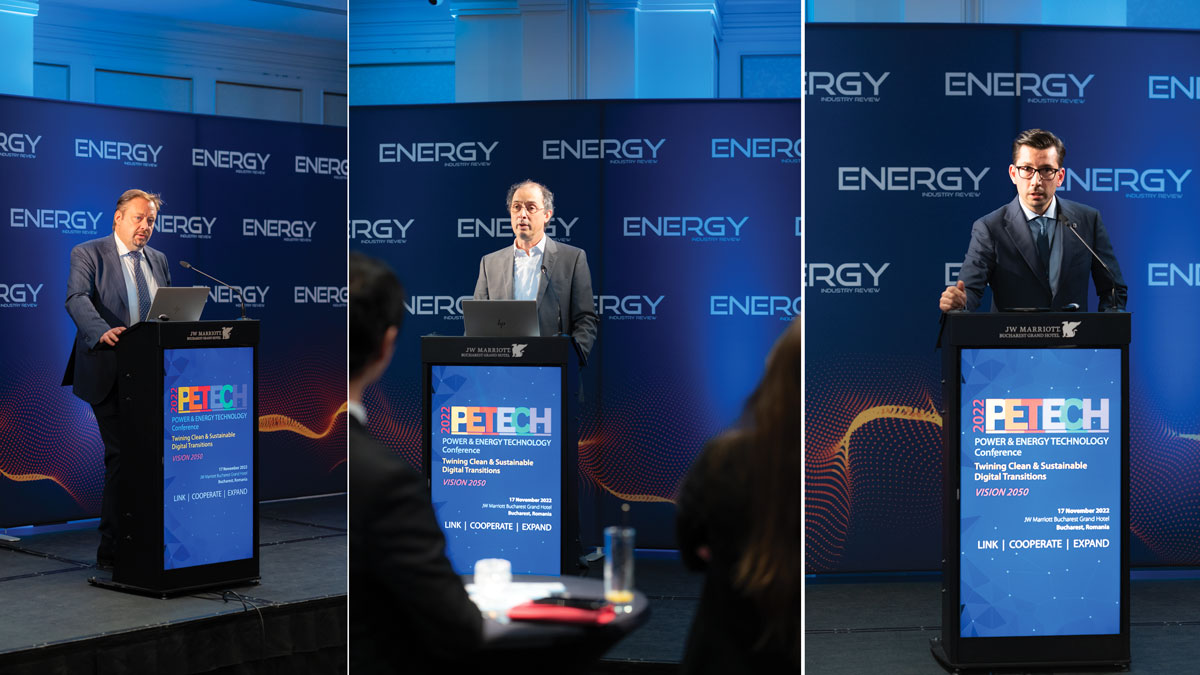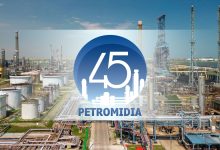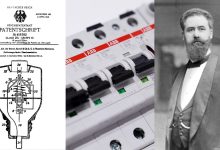PETECH 2022 Vision 2050: Twining Clean & Sustainable Digital Transitions
Energy – one of biggest greenhouse gas emitters – is key to a successful twinning of green and digital transitions. Technologies will play a key role in reducing this sector’s carbon footprint. By 2030, most reductions in CO2 emissions will come from technologies available today. However, achieving climate neutrality and circularity by 2050 will be enabled by new technologies currently at the experimental, demonstration or prototype phase.
The role of technologies in the new geopolitical context towards achieving climate neutrality and circularity by 2050 was the main theme for the Power & Energy Tech Conference Vision 2050 – PETECH 2022.
On November 17th, 2022, in Bucharest, high-level officials, top executives and energy experts from across the full value chain gathered to talk about the challenges and opportunities of energy transition in view of the expanding energy crisis in Europe. They explored how we can ensure energy security and affordability and still accelerate the journey to net zero.
Towards Net Zero: Innovative Technologies, Business Models, Implementation Process and Strategies
Hydrogen could be a vital bridge in the transition to renewables, but investment, vision and commitment are urgently needed at government level. The Committee for Industries and Services of the Romanian Parliament supports and takes a proactive stance in facilitating the use of hydrogen in industries and transport following best practice models existing in Europe, by developing an optimal procedural, regulatory and legal framework, said Oana-Marciana Özmen – Secretary of the Committee for Industries and Services, Parliament of Romania. The hydrogen taskforce was created with the support of Energy Minister Virgil Popescu, the official said, recalling that there are programmes worth more than EUR 1 billion under consideration (through the NRRP) for renewable energy production, hydrogen production and high-efficiency cogeneration.
Zoltan Nagy-Bege, Vice President of ANRE, noted that there is a need for new technical solutions, including hydrogen-specific technical regulations, noting that for the time being the costs associated with hydrogen production are restrictive. But it is only a matter of time before new uses for hydrogen are discovered, and it is important that the hydrogen market in Romania remains attractive to investors.
And for INCDT Comoti the main theme of the day is hydrogen. In his presentation, Leonard Trifu – Marketing Manager, highlighted, along with the other areas of activity of the institute, the experimental model HIDROCOMB – Combustion Chamber with Hydrogen-Natural Gas Mixture Fuel, including its industrial applications. Notable results: flame stability and reducing carbon monoxide emissions.
In the IEA Sustainable Development Scenario, in which global CO2 emissions from the energy sector fall to zero on a net basis by 2070, CCUS accounts for nearly 15% of the cumulative reduction in emissions compared with the Stated Policies Scenario. The contribution of CCUS grows over time as the technology improves, costs fall and cheaper abatement options in some sectors are exhausted. Adam Bott – CCS Business Manager Europe, SLB, gave a clear and comprehensive overview of the complexity and challenges of a carbon capture and storage project. He discussed, inter alia, the key success factors for a storage hub, regulations & policies as a foundational support to CCUS, storage costs and Romania specifics.
NAMR’s perspective on enabling CCS deployment in Romania by improving the legal and regulatory framework, delivered by Florina Sora – Head of CO2 Geological Storage Office, showed that further changes to the policy, legal and regulatory framework are needed to speed up deployment of CCS technologies both at EU and national levels. Nationally, the total onshore CO2 storage capacity is estimated at 514 Mt CO2 (theoretical capacity), to be further assessed by companies that have the required technical and operational capacity, such as petroleum operators. The estimate does not consider the offshore CO2 storage potential, which is also very attractive. For short term, development of CCS projects is most likely to succeed if petroleum titleholders analyse the potential storage capacities of their own blocks. In NAMR’s opinion, oil and gas operators have the best know-how and experience with Romania’s subsurface.
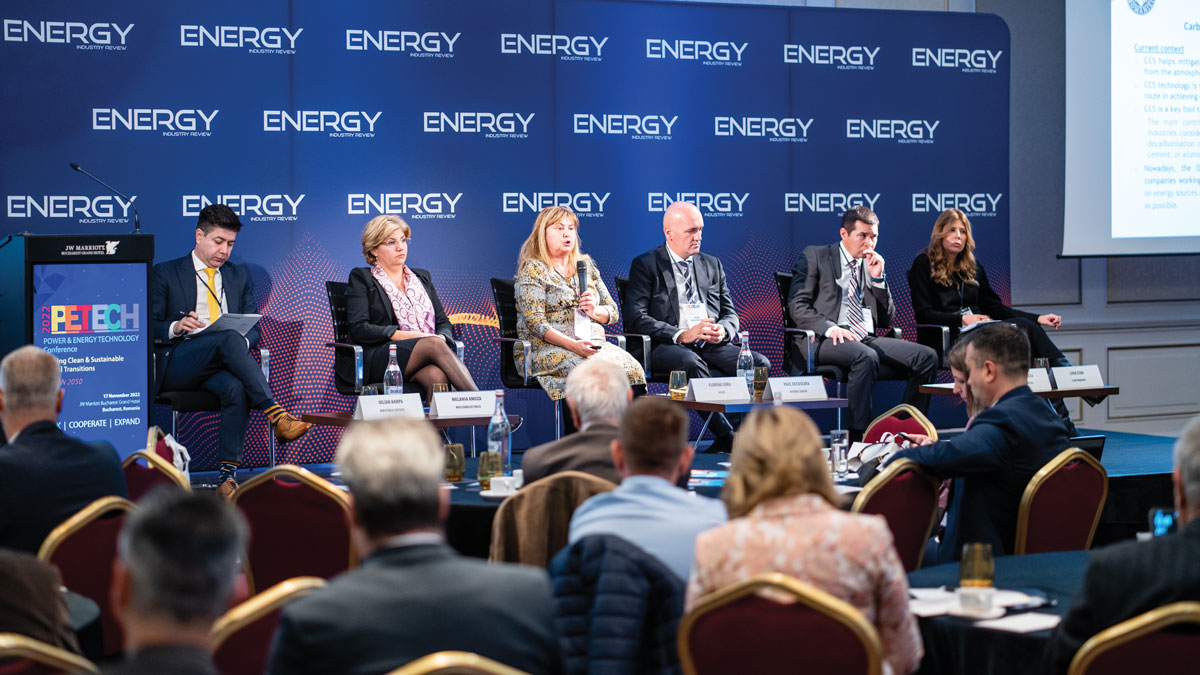
In the Oil and Gas Employers’ Federation (FPPG) view, CCUS and hydrogen also represent solutions for hard-to-decarbonize industries in Romania and not only. FPPG representative Ionut Ciubotaru showed a few examples of green opportunities for the industry besides these – renewable power, electro mobility, H2 mobility, gas mobility, biofuels, geothermal energy. He underlined the importance of blue hydrogen for the time being and Romania’s privileged position as ‘blue hydrogen valley of Europe.’ Blue hydrogen is essential for the energy transition in Romania, a country that is the second largest producer of natural gas in Europe.
Romania’s hydrogen potential in consolidating EU’s energy security was assessed by Livia Stan – Corporate Affairs Director, E.ON Romania. She shared E.ON’s ambition in becoming the first Romanian distribution system operator to test a mix of H2 and CH4 in existing distribution grids on the way to a sustainable and just transition to a net zero economy. The key takeaways of her presentation were: hydrogen is regarded as an indirect form of electrification; climate neutrality is not possible in 2050 without hydrogen, hence sustainable gasification will accompany electrification; gas distribution networks also have a central place in the CO2-neutral energy system.
In her speech, Melania Amuza – Deputy General Director, Commercial and Development of Nuclearelectrica, pointed out the company’s strategic projects towards Romania’s decarbonization and security of supply targets. Considering the aforesaid objectives, Nuclearelectrica reached important milestones – approx. 10 mil. tons yearly GHG reduction, 195 mil. tons GHG reduction from Cernavoda units 1 & 2 since they became operational, 33% clean energy contribution. The level of Nuclearelectrica’s estimated investment by 2030 is EUR 8-9 billion, she added. It will mean that, after 2030, the annual reduction of CO2 emissions with 4 CANDU and one NuScale units may become equal to 24 million tons and the nuclear contribution to clean energy will reach 66%. It is worth mentioning that NuScale SMR is the first small modular reactor design approved by the U.S. Nuclear Regulatory Commission (NRC), since August of 2020. Thus, Romania has the potential to accommodate the first deployment of SMRs in Europe and become a catalyst for SMRs in the region, a base for supporting production and assembly of components and a hub for preparation and training of future operators and specialists.
Alexandra Damascan – President of Serinus Energy – talked about the onshore upstream gas sector in Romania. She especially underlined the challenges and barriers to investment in this sector. “Increasing onshore production is key to Romania’s energy security,” Alexandra Damascan said. Implementing policies that encourage significant investment in domestic natural gas production would not only enhance Romanian energy security but could also drive reduced carbon emissions, while creating significant positive economic impacts, she added.
In Antares Group’s vision, gas mobility can fill the missing pieces of the energy puzzle in Romania. Compressed natural gas (CNG) may be a viable solution for sustainable mobility and transport decarbonisation, Paul Decuseara – Vice President/CEO Green Mobility, said. He told the growth story of the CNG pioneer in Romania – Antares Group. The CNG filling stations network in Romania is deployed by Denisson Energy (part of the group). There are 9 CNG stations equipped with 1000 cm/h compressors, 2 dispensers and payment terminal, located on TEN-T corridors, in proximity to urban nodes. In April 2023 all stations will be operational, Paul Decuseara stated.
Bureau Veritas (BV) have developed a 5-step integrated and digital solution plus a 4-pillars program to take practical steps toward achieving net zero by developing and implementing a clearly defined road map, Carlos Garza – HEBS District Sales Leader, stated. BV’s solution offers support for monitoring assets and value chain activities, improving emission data reliability, and effectively quantifying emissions based on industry best practices. It adds value by identifying company’s emission hotspots, in order to help clients implement clear actions that will steadily and sustainably reduce their environmental impact.
Energy Market in 2022 – Facts and Trends
According to Catalin Stancu – Associated Senior Expert, Horváth, the penetration of renewable energy sources will significantly change the merit order. Horváth is an international, independent management consultancy firm with over 1,100 employees in locations in Europe, the USA, and other global markets. Horváth simulated a scenario of additional RES production required to push the last technology of the merit order and a price decrease of 25% for 2025. In Romania, coal & gas power generation are here to stay at least for the mid-term, mainly due to insufficient new commissioning of (RES) capacities, Catalin Stancu concluded.
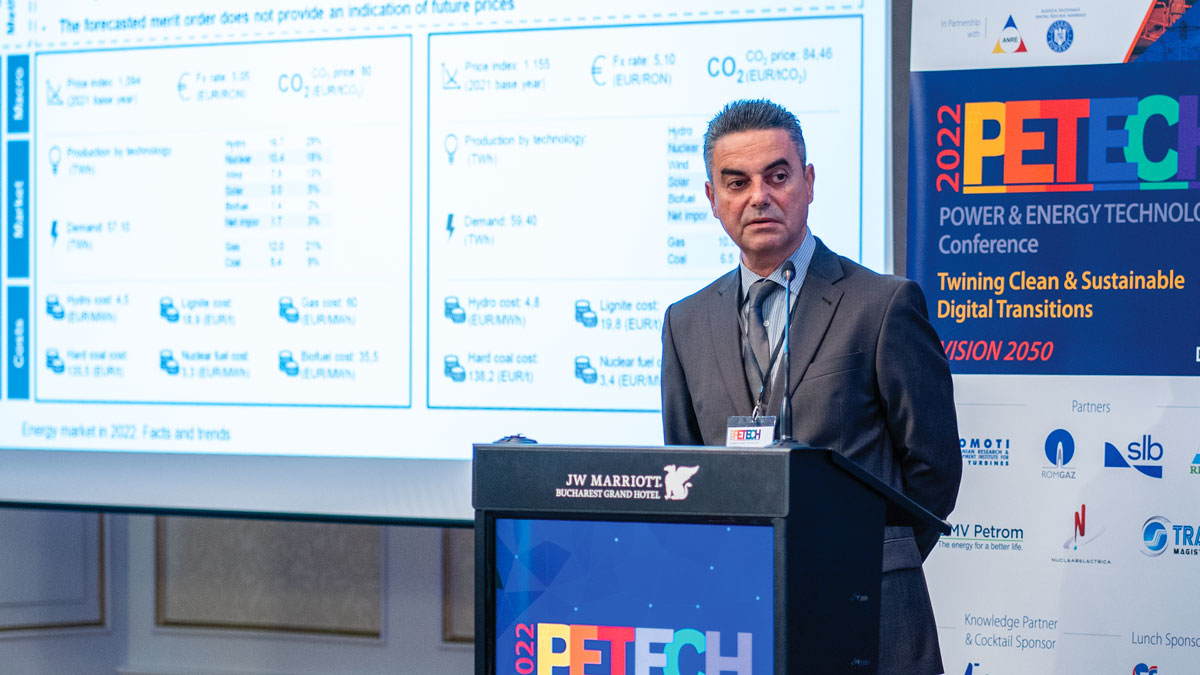
Unlocking Renewable Energy Sources’ Full Potential
The last session of the conference brought meaningful conversations on unlocking renewable energy sources’ full potential between the panellists: Oana-Marciana Özmen, Ciprian Glodeanu – General Manager, AJ Renewables, Daniel Vlasceanu – Managing Partner, Vlasceanu, Nyerges & Partners, Razvan Popa – Partner, Head of Transactions, Jantzen Renewables and Mihai Balan – Executive Director, RPIA. They discussed the current challenges of a renewable energy sources (RES) developer, investor, and lawyer, raising awareness on certain restrictive legal interpretations that may lead to bottlenecks in RES development. The main barriers to RES development include lack of predictability of the legal framework and of the practice of local authorities, lack of predictability of CAPEX, slow pace of grid permitting, availability and cost of financing, lack of mature PPA market, lack of clarity on reinforcement requirements, missing legislation for agrivoltaics, relatively high balancing costs. The panellists also presented what can be improved to the current RES framework and touched upon the competitive advantages that Romania has to offer compared to other areas in the region.
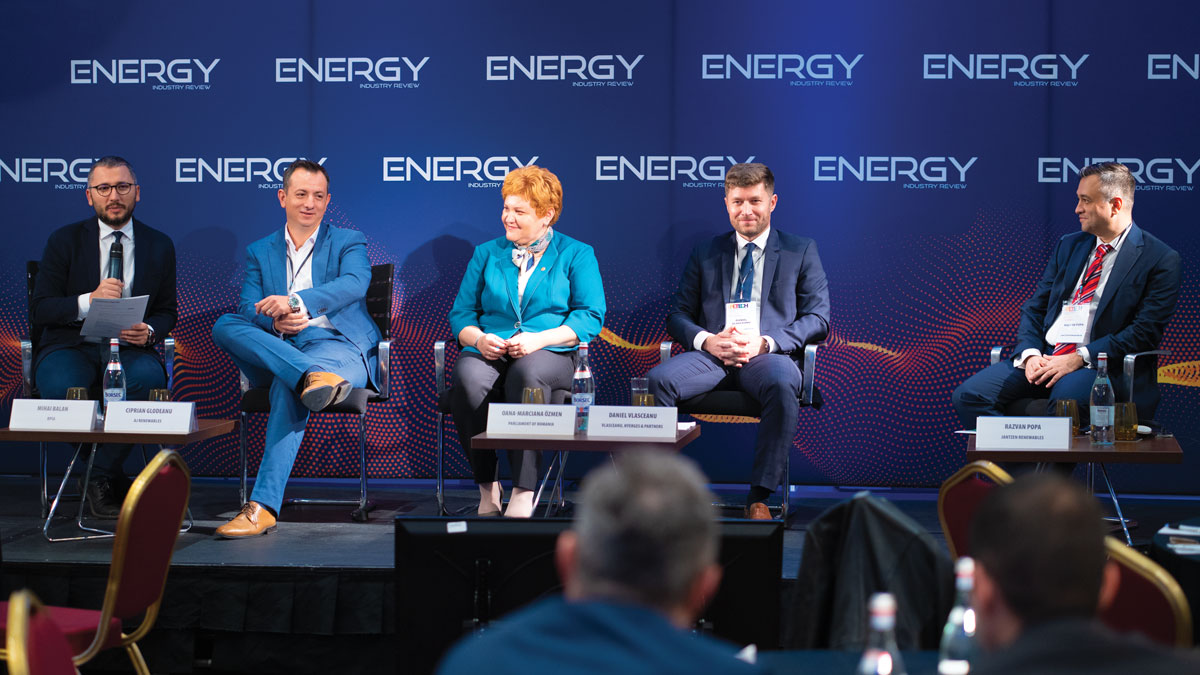
Acknowledging the Contribution of the Oil & Gas Industry to the Romanian Economy
The Contribution of the Oil & Gas Industry to the Romanian Economy, 2nd edition (independent assessment of CPAG – Consilium Policy Advisors Group), regulatory measures and changes in policies at domestic and the EU level, future risks, and uncertainties for the sector, were highlighted by Franck Neel – FPPG President, Catalin Nita – FPPG Executive Director, and Laurian Lungu – CPAG Co-Founder, during the end of the day cocktail.
This third edition of the Power & Energy Tech Conference was another opportunity to demonstrate unity in accelerating the transition towards carbon neutrality.
